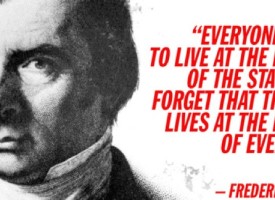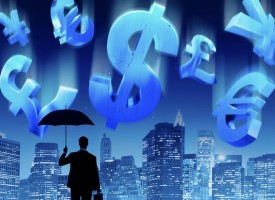Today Gerald Celente just released a series of warnings for 2020.
2020
January 15 (King World News) – Gerald Celente: In the U.S., markets that ended last year on a high note keep hitting new highs this year.
The S&P index ended 2019 up 28.6 percent, its best year since 2013 and one of its best in more than 20 years. The NASDAQ was up 35 percent, its best performance in six years. Small-cap stocks rose 24 percent.
And gold prices, the safe-haven asset that usually go down as equities go up, rose some 19 percent, and silver more than 14 percent last year, and the prices keep moving higher.
TREND FORECAST:
Gold ended the year just 2.4 percent below its six-year high, raising share prices of gold producers with it; Barrick Gold rose more than a third in 2019 and Newmont GoldCorp was up by 23 percent.
With the “anything goes” wild U.S. 2020 Presidential Realty Show® heating up and political uncertainties in the Middle East, Hong Kong, South America, and across the globe also heating up, plus the prospects for a weakening dollar, the upside of gold is stronger than its downside risks.
Indeed, that expectation proved true when the U.S. assassinated Soleimani and gold spiked to a seven-year high of $1,610. As tensions quickly eased, the price settled to $1,556, still showing strength above the $1,550 mark.
Thus, we maintain our forecast for the downside risk of gold to around the $1,390 per ounce mark, with strong probabilities considering the socioeconomic and geopolitical for prices to dramatically spike toward the $2,000 per ounce mark. The futures market still favors higher prices ahead.
Bubble, Bubble, Oil, and Trouble
On the oil front, benchmark Brent crude, now trading at around $64 a barrel, is down some $10 from last year’s high after briefly spiking more than 4 percent following the U.S. assassination of Iranian general Qassem Soleimani on 3 January.
With Middle East tensions having subsided but still volatile, prices remain in the mid-$60 range even though U.S. oil inventories have unexpectedly increased. A relatively strong economy and low unemployment may be buoying oil prices expectations of demand rising.
These numbers underpin a Financial Times-Peterson Foundation poll this month that found 51 percent of those surveyed believe Donald Trump’s policies have helped the economy – the first time a majority of respondents felt this way since the poll began asking the question last October.
More Monetary Methadone
The presidents of the Federal Reserve Banks of Dallas and Boston said in independent comments this month that they see no cause on the horizon to raise interest rates. Both said it would take “significant” changes in inflation or other negative factors to change their minds.
When the Fed’s policy officials met in mid-December, they forecast no change during 2020 in the current, already-low benchmark rates of 1.5 to 1.75 percent.
John Williams, president of the Fed bank in New York, has gone further, saying that interest rates in this general vicinity will persist deep into the 2020s.
Ben Bernanke, who chaired the Fed from 2006 to 2014, said recently that the Fed has powerful tools to manage rough spots. If crises arise, he urged that the bank continue to use “quantitative easing” – in which the Fed buys government bonds to inject cash into the markets – and “forward guidance,” in which Fed officials speak publicly about the likely direction of future policies so as to not surprise the markets…
ALERT:
Mining legend Ross Beaty (Chairman Pan American Silver) is investing in a company very few people know about. To find out which company CLICK HERE OR ON THE IMAGE BELOW.
 Sponsored
Sponsored
If the economy tailspins, Bernanke added, the Fed should be creative in finding new ways to smooth things out. “Within its legal authorities, it should not rule out other options,” he said.
TREND FORECAST:
Ben Bernanke, the Fed Chair who did not see the Panic of ’08 coming and denied it as it was happening, is wrong again. When the “Greatest Depression” strikes in 2021, central bank monetary stimulus will not reverse the sharp economic slump.
Indeed, with interest rates across the globe at or beyond all-time lows, from the International Monetary Fund to the World Bank, financial institutions are fully aware of monetary stimulus limitations. Thus, they are calling on governments to go deeper in debt and attempt to pump up flattening economies with fiscal stimulus measures such as infrastructure investment.
Money Junkies
Over the last several weeks, as we have reported in the Trends Journal, U.S. equity markets have been buoyed by the Fed, which has pumped trillions of dollars into the overnight repurchase agreement (“repo market”) for months to keep interest rates low and steady.
The Fed did it again on the second day of the new year, opening $56.7 billion to banks to keep money flowing among financial institutions. This followed $56.5 billion in mid-December. On 8 January, the bank made available another $46.6 billion to money markets and, the next day, $83.1 billion to the repo market.
The Fed has said it will keep the liquidity door open at least through January – longer than the bank to ensure markets start the new year without the sudden spikes in short-term interest rates that plagued markets last fall.
Fed vice-chair Richard Clarida said that the bank expects to ease out of the repo market “gradually” this year but “stands ready to adjust the details of this program as appropriate.”
Housing Starts and Home Prices Up
Home construction rose 3.2 percent from October to November 2019. The Fed’s three interest rate cuts during the year contributed to the gain.
Rising demand for new homes also pushed up prices to a nationwide average of $316,000, a new record…
Listen to the greatest Egon von Greyerz audio interview ever
by CLICKING HERE OR ON THE IMAGE BELOW.
Home construction rose 3.2 percent from October to November 2019. The Fed’s three interest rate cuts during the year contributed to the gain.
Rising demand for new homes also pushed up prices to a nationwide average of $316,000, a new record.
But troubling indicators lie beneath those headlines.
Big Apple Real Estate Shows Soft Spot
Manhattan real estate sales had their slowest year since 2011, with average prices dropping by almost 40 percent to a four-year low in 2019’s third and fourth quarter. Typically, prices sag to this degree only during a recession. Homes priced above $25 million, however, set a record with 56 sales.
Employment Figures Lag
The U.S. economy added 145,000 jobs in December, compared to the 160,000 that analysts had forecast. Wages gained 2.9 percent; the expectation had been 3.1.
The shortfalls are small but indicate that the world’s slowing economy is reaching U.S. shores.
States Face Shrinking Economies
The states of Connecticut, Delaware, Kentucky, Montana, New Jersey, Oklahoma, Pennsylvania, Vermont, and West Virginia will see their economies contract during the first half of 2020, according to a study by the Federal Reserve Bank of Philadelphia.
West Virginia’s decline will be the most severe, in part to rolling bankruptcies across the coal industry. Factors affecting other states’ outlooks include fallout from the U.S.-China trade war, slowdowns in manufacturing, and aging populations.
Danger: U.S. Corporate Debt Rising
Debts that major U.S. corporations owe to suppliers, service companies, and other non-financial institutions hit $10 trillion in 2019, equivalent to about half of the nation’s Gross Domestic Product (GDP).
This is the highest proportion of debt to GDP since the third quarter of 2008, when the debt totaled $6.6 trillion, or 44 percent of GDP, and sets a new record.
Adding in the same kind of debts of smaller businesses brings the total tab to about $15.5 trillion.
The rising debt burden has led the International Institute of Finance’s Global Debt Monitor to switch on its “amber warning light” for U.S. corporations, citing “worries about vulnerabilities in the corporate sector,” including uncertainties surrounding international trade and stocks that are valued above companies’ profit potential.
Fitch Ratings warns that slowing global economic growth, coupled with low interest rates that lure more loans, will weigh on 2020’s credit markets and could cause a large number of borrowers to fall into arrears or default altogether if the world economy brakes more quickly than expected.
Globally, corporations have taken on about $3 trillion worth of “leveraged loans” – a polite term for high-risk loans and junk bonds. About a quarter of this debt is held in “collateralized loan obligations,” the same kind of financial structure that bought subprime mortgages and then collapsed the economy in 2007.
Banks hold about 40 percent of this risky debt. Much of the rest is held by entities that don’t open their books for inspection, such as hedge funds and private investors. That means if the lending tower falls, there will be little warning the way there would be if regulators had access to holders’ books…
IMPORTANT:
To learn which junior explorer is looking to drill multiple major tier one discoveries CLICK HERE OR ON THE IMAGE BELOW
 Sponsored
Sponsored
The International Monetary Fund estimates that an economic downturn half as severe as the 2007 crisis could push as much as $19 trillion in debt to the point at which borrowers wouldn’t be able to cover their interest payments.
TREND FORECAST:
The cheap money binge that has artificially propped up equities, home sales, and corporations will, at some point, dry up. We maintain our forecast that President Trump will pressure the Federal Reserve to bring U.S. interest rates to negative or zero before November. Thus, the lowering of interest rates will weaken the dollar, which in turn will push gold prices higher.
Not a Happy Retail Holiday
Those sentiments were reflected in holiday retail spending, which didn’t bring retailers joy. The National Retail Federation predicted sales would exceed the 2018 season by 4.2 percent, instead, they rose by only 3.4 percent.
In contrast, the previous five seasons averaged a gain of 3.7 percent annually.
In-store sales gained only 1.2 percent, while online shopping grew by about 15 percent.
As long forecast by Gerald Celente’s Trends 2000 “Pall on the Malls” forecast, for the brick-and-mortar retailer, prospects remain bleak. This month, Moody’s Analytics reported that mall store vacancies have risen to 9.7 percent, a 20-year high since Moody’s began tracking the number in 2000 when the rate was 5.3 percent.
More than 9,300 stores closed in 2019 and more are disappearing: the Pier One import chain announced plans to close 450 stores in a last-ditch attempt to stay alive after third-quarter sales in 2019 slumped 11 percent. Macy’s announced the closure of 30 stores as sales dropped 3.6 percent during 2019’s final quarter.
TRENDPOST:
Although holiday sales were soft, consumers still larded on more debt – enough that credit rating agency TransUnion forecasts that the number of people behind on their credit card bills by 90 days or more will rise to 2.01 percent in 2020. That’s far less than during the depths of the Great Recession but still a negative trend.
A study by ScoreSense, a credit reporting agency, found that 53 percent of Americans have been turned down for a credit card or other loan because of poor credit. The problem is worsened, in part, by credit card companies’ eagerness to dispense plastic; the survey found that 38 percent of Americans have three or more credit cards.
Meanwhile, American Express and Discover report that they will tighten credit requirements in anticipation of a faltering economy.
Automakers Hit Speed Bumps
For the second straight year, auto sales fell in China, the world’s largest auto market. Vehicle sales in 2019 were down 8.2 percent from 2018, when sales slowed 5.8 percent.
The figures mirror a global trend. GM reported sales of 2.9 million vehicles in 2019, a 2.3 percent drop from 2018. Sales in 2019’s fourth quarter were down an average of 6.3 percent for all GM brands, compared to a year previous, ranging from an 8.5 percent drop for GM to 2.2 percent for Cadillac.
Ford reported selling 2.1 million vehicles in 2019, 3.2 percent fewer than in 2018. Truck sales were up but couldn’t offset sales losses for sedans and SUVs.
The U.S. auto industry’s sales overall fell 1.6 percent in 2019.
TRENDPOST:
Next to housing, autos are the next biggest consumer purchase. Thus, auto sales are a leading economic indicator; as auto sales go, so goes the economy.
The Rich Get Richer
According to the Bloomberg Billionaires Index, the world’s 500 richest individuals added $1.2 trillion to their net worth in 2019, boosting their total value by about 20 percent to $5.9 trillion.
TRENDPOST:
In the United States, where three people, Warren Buffett, Jeff Bezos, and Bill Gates have more money than half of America’s population combined, wealth inequality has become a key theme among Democratic presidential hopefuls.
And, as noted in one of our Top Trends for 2020, “New World Disorder,” the rich getting richer as majorities are getting poorer has people across the globe taking to the streets. As global economies slow down, the income inequality gap will widen and the protests, riots, and demonstrations will accelerate.
As Gerald Celente has long said, “When people lose everything, and have nothing left to lose, they lose it.”
All-Time Record
ALSO RELEASED: WARNING: Look At What Just Hit An All-Time Record CLICK HERE TO READ.
***Alasdair Macleod discusses the wild gold trading in gold this week, what to expect for gold, silver and the markets in 2020 and much more and you can listen to his powerful KWN audio interview by CLICKING HERE OR ON THE IMAGE BELOW.
© 2020 by King World News®. All Rights Reserved. This material may not be published, broadcast, rewritten, or redistributed. However, linking directly to the articles is permitted and encouraged.









